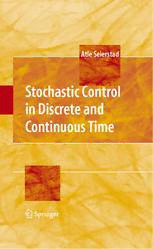Table Of ContentStochastic Control in Discrete and Continuous Time
Atle Seierstad
Stochastic Control in Discrete
and Continuous Time
ABC
AtleSeierstad
DepartmentofEconomics
UniversityofOslo
1095Blindern
0317Oslo
Norway
[email protected]
ISBN978-0-387-76616-4 e-ISBN978-0-387-76617-1
DOI:10.1007/978-0-387-76617-1
LibraryofCongressControlNumber:2008938655
MathematicsSubjectClassification(2000):90C40,93E20
(cid:176)c 2009 SpringerScience+BusinessMedia,LLC
Allrightsreserved.Thisworkmaynotbetranslatedorcopiedinwholeorinpartwithoutthewritten
permissionofthepublisher(SpringerScience+BusinessMedia,LLC,233SpringStreet,NewYork,NY
10013,USA),exceptforbriefexcerptsinconnectionwithreviewsorscholarlyanalysis.Useinconnection
withanyformofinformationstorageandretrieval,electronicadaptation,computersoftware,orbysimilar
ordissimilarmethodologynowknownorhereafterdevelopedisforbidden.
Theuseinthispublicationoftradenames,trademarks,servicemarks,andsimilarterms,eveniftheyare
notidentifiedassuch,isnottobetakenasanexpressionofopinionastowhetherornottheyaresubject
toproprietaryrights.
Printedonacid-freepaper
springer.com
ThisbookisdedicatedtoalynxIsawin
MaridaleninthevicinityofOsloinApril
2006.
Withouthavingreadthisbook(sofar),yet
maybeithuntsaccordingtoanoptimized
piecewisedeterministic process.
Preface
Thisbookcontainsanintroductiontothreetopicsinstochasticcontrol:discretetime
stochasticcontrol,i.e.,stochasticdynamicprogramming(Chapter1),piecewisede-
terministiccontrolproblems(Chapter3),andcontrolofItodiffusions(Chapter4).
The chapters include treatments of optimal stopping problems. An Appendix re-
calls material from elementary probability theory and gives heuristic explanations
ofcertainmoreadvancedtoolsinprobabilitytheory.
The book will hopefully be of interest to students in several fields: economics,
engineering,operationsresearch,finance,business,mathematics.Ineconomicsand
business administration, graduate students should readily be able to read it, and
the mathematical level can be suitable for advanced undergraduates in mathemat-
ics and science. The prerequisites for reading the book are only a calculus course
andacourseinelementaryprobability.(Certaintechnicalcommentsmaydemanda
slightlybetterbackground.)
Asthisbookperhaps(andhopefully)willbereadbyreaderswithwidelydiffer-
ingbackgrounds,somegeneraladvicemaybeuseful:Don’tbeputoffifparagraphs,
comments, or remarks contain material of a seemingly more technical nature that
you don’t understand. Just skip such material and continue reading, it will surely
notbeneededinordertounderstandthemainideasandresults.
The presentation avoids the use of measure theory. At certain points, mainly in
Chapter4,certainmeasuretheoreticalconceptsareused,theyarethenexplainedin
aheuristicmanner,withmoredetailedbutstillheuristicexplanationsappearingin
Appendix.Thechosenmannerofexpositionisquitestandard,exceptinChapter3,
where a slightly unusual treatment is given that can be useful for the elementary
typesofproblemsstudiedthere.Inallchapters,problemswithterminalrestrictions
areincluded.
OnemightdoubtifIto-diffusionscanatallbepresentedinausefulwaywithout
using measure theory. One then has to strike a balance between being completely
intuitiveandatleastgivingsomeideasaboutwhereproblemsliehidden,howproofs
canbeconstructed,anddirectionsinwhichamoreadvancedtreatmentmustmove.
Ihopethatmychoicesinthisrespectarenottoobad.
vii
viii Preface
A small chapter (Chapter 2) treatsdeterministic control problems and has been
included because it makes possible a very simple exposition of ideas that later on
reappearinChapters3and4.Inaddition,andmoreformally,certainproofsinChap-
ter3makeuseofprovenresultsinChapter2.
Thelevelofrigorvariesgreatly.Formalresultsshouldpreferablybestatedwill
fullrigor,butcertaincompromiseshavebeenunavoidable,especiallyinChapter4,
butinfactinallchapters.Thedegreeofrigorintheproofsvariesevenmore.Some
proofs are completely heuristic (or even omitted), other ones are nearly, or essen-
tially, rigorous. Quite frequently, first nonrigorous proofs are presented, and then,
perhapsannoyinglyoften,somecommentonwhatislackingintheproofs,orhow
theymightbeimprovedupon,areadded.
Hopefully, what might be called introductory proofs of the most central results
areeasytoread.Otherproofsofmoretechnicalmaterialmaybequitecompact,and
thenmoredifficulttoread.Sothereadermayfeelthatreadabilityvariesalot.Ina
bookofthistypeandlength,itwasdifficulttoavoidthisvariabilityinthemanner
ofexposition.
Altogether, there are a great number of remarks in the text giving refinements
or extension of results. On (very) first reading, it is advisable to skip most of the
remarks and concentrate on the main theory and the examples. Asterisks, usually
one(*),areusedtoindicatematerialthatcanbejumpedoveratfirstreading;when
two asterisks (**) are used, it indicates in addition that somewhat more advanced
mathematicaltoolsareused.
Solvedexamples,exampleswithanalytical(orclosedform)solutions,playabig
roleinthetext.Theaimistogivethereaderafirmerunderstandingofthetheoret-
ical results. It will also equip him or her with a better knowledge of how to solve
similar, simple problems, and an idea of how solutions may look like in slightly
morecomplicatedproblemswhereanalyticalsolutionscannotbefound.Thereader
shouldgettoknow,however,thatmostproblemscannotbesolvedanalytically,they
neednumericalmethods,nottreatedinthecurrentbook.
On the whole, sufficient conditions for optimality are proved with greater rigor
(sometimes even with full rigor) compared with proofs of necessary conditions.
Even if the latter proofs are heuristic, the necessary conditions that they seem to
providecanbecomparedwiththesufficientconditionsestablished,andtheformer
(slightlyimprecise)conditionscantellhowusefulthelatterconditionsare,inother
wordshowfrequentlywecanhopethatthesufficientconditionscanhelpussolve
theoptimizationproblemsweconsider.
Anumberofexercises,withanswersprovided(exceptforafewtheoreticalprob-
lems),havebeenincludedinthebook.
Forthereaderwantingtocontinuestudyingsomeofthethemesofthisbook,or
whowantstoconsultalternativeexpositionsofthetheory,asmallselectionofbooks
andarticlesareprovidedintheReferences.Theseworksarealsoreferredtoatthe
endsofthechapters.Thefewtitlesprovidedcanonlygivesomehintsastowhere
one can seek more information; for more extensive lists of references, one should
lookintomorespecializedworks.
Preface ix
Sections 1.1 and 1.2 have, with some changes, appeared in the book by
K.Sydsæteretal.(2005),FurtherMathematicsforEconomicAnalysisbyPrentice
Hall.
EarlyversionsofthechaptershavebeentriedoutincoursesforPhDstudentsin
economics,fromwhomusefulfeedbackisgratefullyacknowledged.
PeterHammondhasreadearlyversionsofthechaptersinthebookandgivena
tremendousamountofusefuladvice,muchmorethanhesurelyremembers.
Knut Sydsæter and Arne Strøm have read and given comments on parts of the
bookandalsohelpedintechnicalmattersrelatedtopresentationandlayout.Also,
Tore Schweder has helped me at certain points. For all this help, I am extremely
grateful.
Allerrorsandothershortcomingsareentirelymyown.
The Department of Economics at University of Oslo has over the years made
available an excellent work environment and Knut Sydsæter and Arne Strøm, my
co-mathematicians at this department, have carried out more than their share of
work related to teaching and advising students of all types, which has given me
moretimetoworkonthisbook,amongotherthings.Thanksagain.
Finally, I am very grateful for the excellent technical support provided by
Springerconcerningthepreparationofthefinalversionofthemanuscript.
Oslo,Norway AtleSeierstad
October2007

